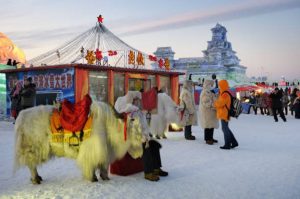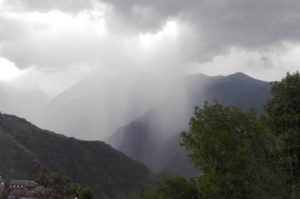Grand Yak Festival Thakum: The serene and picturesque highlands of Thakum, a remote Himalayan settlement perched near the Indo-Nepal border, have recently transformed into a vibrant hub of culture, tradition, and celebration with the onset of the Grand Yak Festival, locally revered as Chauri Mahotsav.
This annual event, now in its eighth edition, is much more than just a festival—it is a vivid showcase of the region’s ancient customs, deep-rooted agricultural and pastoral traditions, and the close-knit relationship that local communities share with nature and their revered yak herds. Held on April 13 and 14, coinciding with the Nepali New Year celebrations, the festival has turned this otherwise tranquil landscape into a bustling destination for both domestic and international tourists.

Draped in fluttering prayer flags, echoing with the soulful rhythms of traditional music, and brimming with colorful attire and joyous celebrations, Thakum has become a symbol of Himalayan cultural pride. What was once a little-known village path now teems with curious travelers, adventure enthusiasts, environmentalists, and cultural connoisseurs, all eager to witness the unique festival that places the majestic yak at the center of attention.
The Chauri Mahotsav, which honors the contribution of yaks to mountain life—be it in transport, dairy production, or traditional rituals—has emerged as a powerful magnet for eco-tourism, drawing crowds to the nearby Sandakphu region, the highest point in West Bengal.
With snow-capped peaks in the backdrop and a crisp mountain breeze carrying the scent of burning juniper and butter lamps, the festival encapsulates the mystical charm of the Himalayas. This growing tourist interest is not just a fleeting seasonal spike; rather, it reflects a deeper appreciation for the rich cultural tapestry of the Himalayan communities—their resilience, spirituality, sustainable lifestyles, and harmonious coexistence with nature.
From yaks being paraded and adorned in vibrant woolen decorations, to stalls selling locally-produced yak cheese, butter, and handmade woolen crafts, the festival offers an immersive experience that connects people not only to the land but to the stories and struggles of those who call it home.
As tourists continue to arrive in greater numbers, Thakum and the surrounding Singalila ridge are steadily emerging on the map as must-visit destinations, not just for trekking and panoramic mountain views, but also for their authentic cultural experiences, which are increasingly rare in a rapidly globalizing world. The Grand Yak Festival, thus, stands not merely as a celebration, but as a bridge—linking the traditional and the modern, the local and the global, and the sacred and the scenic.
Celebrating the Yak: A Cultural and Economic Pillar
Organized by the yak herders and farmers of Phalelung Rural Municipality in collaboration with the Nepal Tourism Board and other local bodies, the festival marks the Nepali New Year 2081-82. This eighth edition of the Chauri Mahotsav features around 130 yaks, offering visitors a rare glimpse into the traditions surrounding these majestic animals. The event includes the sale of various dairy products, educational exhibits, and handouts about yaks, aiming to promote eco-tourism, support wildlife conservation, boost cross-border tourism, and sustain the yak-keeping livelihood.
Keshari Gurung, an eco-tourism activist, emphasized the festival’s role in highlighting the significance of yaks in the region’s ecology and economy. “The goal is to promote eco-tourism, support wildlife conservation, boost cross-border tourism, and sustain the yak-keeping livelihood,” she stated.
Grand Yak Festival Thakum: Tourist Influx and Accommodation Challenges
The festival’s allure has led to a significant increase in tourist footfall in Sandakphu, the highest point in West Bengal. Chandan Pradhan, president of the Singalila Land Rovers’ Owners Association (SLROA), noted that accommodations in Sandakphu are fully booked, with most of the Nepal side also at capacity. “With the festival being organized during peak season, we are getting a lot of queries. Unfortunately, we have to turn tourists away as the region is fully packed till the end of April,” Pradhan said.
On Saturday, about 30 vehicles carrying nearly 200 tourists departed for Sandakphu and Tumling, indicating the high demand and interest in the region during the festival period.
Grand Yak Festival Thakum: Environmental Concerns Amidst Tourism Boom
While the festival has boosted tourism, it has also raised concerns about environmental sustainability. Stakeholders have urged the government to take immediate steps to make Sandakphu a safer destination. Bhaskar Das, a governing council member of the Indian Mountaineering Federation, highlighted issues such as the lack of medical facilities and the irresponsible behavior of some tourists, including littering and alcohol consumption at high altitudes. He advocated for measures like mandatory fitness certificates for visitors and the provision of oxygen cylinders and first aid kits.
Pradeep Lama, General Secretary of the Darjeeling Association of Travel Agents, suggested that the local administration should collaborate with the Shashastra Seema Bal to provide medical assistance during emergencies, similar to practices in high-altitude areas of Sikkim.
Grand Yak Festival Thakum: Weather Challenges and Infrastructure Issues
The region has also faced challenges due to untimely snowfall, which has caused major dents in tourism. In March, the SLROA members attempted to clear snow from a 3 km stretch from Beekaybhanjyang to Sandakphu but found it impossible due to more than 3 feet of snow. Chandan Pradhan expressed frustration over the lack of action from the Public Works Department and the Forest Department, emphasizing the need for road clearance to facilitate tourist access.


Despite these challenges, the snowfall has also revived hopes for increased tourist footfall. Sandakphu received up to two inches of snowfall in January, offering panoramic views of the Kanchenjunga, Everest, Makalu, and Lhotse peaks, thereby attracting nature lovers and adventure enthusiasts.
Grand Yak Festival Thakum: A Harmonious Blend of Culture, Nature, and Tourism
The Grand Yak Festival in Thakum stands as a testament to the region’s rich cultural heritage and its potential for sustainable tourism. By celebrating traditional practices and addressing environmental concerns, the festival aims to create a harmonious balance between cultural preservation and economic development.
As tourists continue to flock to Sandakphu and its surrounding areas, the collaborative efforts of local communities, authorities, and environmentalists will be crucial in ensuring that the region remains a pristine and welcoming destination for generations to come.
Grand Yak Festival Thakum: Sandakphu Trekking and Tourism
Also read: Home | Channel 6 Network – Latest News, Breaking Updates: Politics, Business, Tech & More

